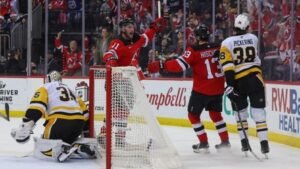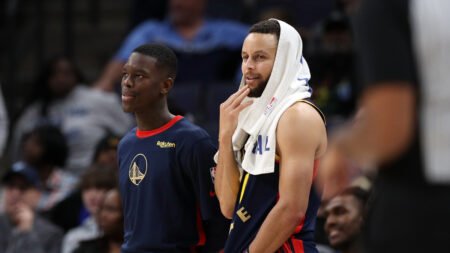After taking care of their first order of business by hiring Kenny Atkinson to be their new head coach, the Cavaliers have now checked the most important item off their summer to-do list, agreeing to terms with Donovan Mitchell on a new three year, $150.5 million maximum contract extension, according to ESPN’s Adrian Wojnarowski.
So why not a four-year extension worth over $200 million? It appears that this deal is structured to give all parties what they really want. According to Woj, this deal gives the Cavs “the stability of their franchise player under contract beyond next season.” For Mitchell, he is now on the “fast-path to the 10-year service criteria allowing him to pursue a 5-year, $380M-plus extension in 2027.”
Since landing in Northeast Ohio in September 2022, Mitchell has played the best basketball of his seven-year career, averaging 27.5 points, 4.6 rebounds, 5.2 assists and 1.6 steals per game across two seasons in Cleveland. He led the Cavs to consecutive postseason appearances, including the franchise’s first playoff series win since LeBron James left for Los Angeles — and its first series win without James since 1993 — with a first-round victory over the Orlando Magic back in April.
The Cavs needed the full seven games to take down the physical, young Magic, and needed Mitchell — still not fully himself after missing 18 games post-All-Star break with left knee issues that wound up requiring platelet-rich plasma injections — to lead the way. He scored 14 points in the fourth quarter of Cleveland’s win in Game 5; hung 50, including all 18 points the Cavs scored in the fourth, to give them a chance in a close Game 6 loss; and bounced back with 39 to go with nine rebounds, five assists, a steal and a block in 45 minutes in the Game 7 clincher.
That victory earned Cleveland a date with the top-seeded Celtics in Round 2. The Cavs wouldn’t linger long in the series, bowing out in five games, with Mitchell missing the final two contests with a left calf strain. Before being relegated to street clothes, though, Mitchell fared as well as any individual player in the postseason did against Boston, averaging 31.7 points, 6.3 rebounds and 5.3 assists in 39.9 minutes per game, shooting 51.5% from the field and 53.3% from 3-point range against the eventual NBA champions — including a 29-7-8 effort in a Game 2 win, one of just three contests the C’s dropped en route to the title.
That sort of production against an elite Celtics defense highlights the level that Mitchell can reach as an offensive engine — an all-court problem capable of dominating the game at all three levels, equally adept at orchestrating in the pick-and-roll to get downhill into the paint, stepping back behind a screen to fire a pull-up 3 off the dribble, working off the ball as a catch-and-shoot threat, or bending the defense to draw help and create open looks for his teammates.
Only five players in the NBA last season used at least 30% of their team’s offensive possessions, dished an assist on more than a quarter of their teammates’ baskets, and posted a true shooting percentage (which factors in 2-point, 3-point and free-throw accuracy) above 59%. The list: MVP finalists Shai Gilgeous-Alexander and Luka Dončić, two-time MVP Giannis Antetokounmpo, All-NBA Second Team selection Jalen Brunson, and Mitchell, who looked to be well on his way to a second straight All-NBA nod himself before the knee issues that dropped him below the 65-game threshold for award eligibility.
Perhaps most enticing: At 27 and just entering his athletic prime, Mitchell might be getting even better. He posted the highest free-throw attempt, assist and rebounding rates of his career last season, all while playing the best defense of his career despite shouldering such a significant workload.
Add it up and, on a per-possession basis, a number of advanced metrics — estimated plus-minus, value over replacement player, box plus-minus, The BBall Index’s LEBRON, Opta’s DRIP, Kostya Medvedovsky’s DARKO and Neil Paine’s Estimated RAPTOR — all pegged Mitchell as a top-10-to-15 player in the league last season. Which is to say: precisely the kind of building block that a franchise like Cleveland, which doesn’t boast a major track record of success in free agency, wants to lock in as a cornerstone for as long as possible.
The Cavs still have plenty of questions to answer. Can Atkinson squeeze more synergy and production out of the Mitchell-Darius Garland partnership in the backcourt and the Jarrett Allen-Evan Mobley tandem up front than predecessor J.B. Bickerstaff was able to? Can Garland bounce back from an injury-wracked and largely lost season to reclaim the All-Star status he’d reached before Mitchell’s arrival? Is Mobley poised for another leap on the offensive end? How will team president Koby Altman work to continue to maximize the roster around that core four — and might he be better served moving on from one (or more) pieces to more fully round out the rotation? And even if the Cavs leap every developmental hurdle and nail every transactional decision along the way, will it be enough to meaningfully contend with a monster like the Celtics for Eastern supremacy?
The answers to those questions will come soon enough. For now, though, Cleveland fans can take solace in finding certitude on the biggest issue that had been hanging over their heads: Mitchell’s not going anywhere, which means the Cavs still have the chance to get where they want to go.
Read the full article here














